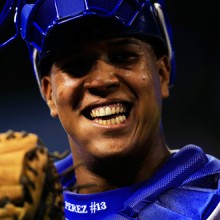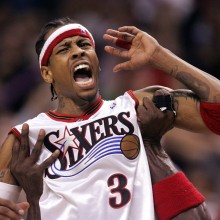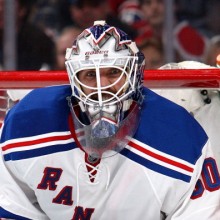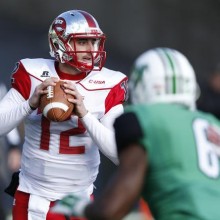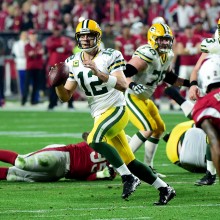We are a few months from the start of the college basketball season, and the road to the 2014 NBA Draft has become. To kick things off, I am going to spend the next couple of weeks looking at this year’s senior class and some brief notes on areas where they need to show improvement to maximize their value at the next level.
These are not meant to replace scouting reports, which will come out during the season. These are not all-inclusive and just meant as a brief primer for those who want to track draft prospects throughout the season. These are also not in any particular order other than who I choose to write about each post.

Javon McCrea, Buffalo, Forward, 6’7, 250
(2012-13) 18.0 ppg, 7.9 rpg, 1.3 spg, 2.6 bpg, 55.7 FG%, 70.8 FT%
McCrea has had a solid 3 years in the MAC and should be a frontrunner for MAC Player of the Year in his senior season. McCrea has developed well as a low post presence, and his footwork has come a long way in 3 years. He is very effective around the basket, can score with either hand, and has developed a nice touch on his shot. McCrea is very active on the offensive boards and can create multiple possessions for his team. Though solidly built, he is light on his feet. On defense, McCrea reacts very well as a help defender and blocks shots well for his size.
What he needs to show this season: McCrea needs to develop skills, such as multiple post moves, as he tends to go back to many of the same moves multiple times in a row and defenses adjust. It will also be important for McCrea to become more reliable in the mid-range game, both with his shot and his ability to take his man to the basket. Buffalo has relied a lot on McCrea’s ability to score and this can lead him to force some bad shots or to try and bully his way to the basket against multiple defenders. Also, McCrea needs to work on his ballhandling, especially not leaving the ball exposed to be stripped. McCrea should continue to work on his defensive footwork and using his body to force offensive players away from the basket. There is physical talent here, but McCrea needs to develop a better understanding of the game.
DeAndre Kane, Iowa State, Guard, 6’4, 195
(2012-13 with Marshall) 11.5 ppg, 4.8 rpg, 58.5 FG%, 83.5 FT%
Kane is the latest player to head to Iowa State to finish up their college career. Kane has good size and speed for the point position, and a very quick first step to the basket. Once in the lane he is capable of scoring in a variety of ways around the basket or finding an open teammate. He is capable of knocking down his jumper off the dribble and has shown good range. Kane likes to push the ball in the open court and is tough to stop once he gets moving, though control problems plague him in both the halfcourt and in transition.
What he needs to show this season: Control has always been an issue for Kane, though he assumed a large burden producing for Marshall as a distributor and as a scorer. He should have plenty of other scoring options surrounding him at Iowa State, so he shouldn’t have to force too much, but even so, he must cut down on the turnovers. Hopefully, this should also allow him to take better shots. He will face some very good perimeter defenders and he will likely not be able to force the action to the right side like he usually does, so he needs to get better control with his left. On the flip side, Kane will really need to step up his perimeter defense. He isn’t very active and will often play defense standing straight up. That’s not going to cut it in the Big 12. Iowa State likes to push the pace often, and it will often fall on Kane to control the team on both ends of the floor. Kane will be 25 years old by the 2014 Draft, so it will be interesting to see how much he can alter his style of play.
Tarik Black, Kansas, Forward, 6’9, 260
(2012-13 with Memphis) 8.1 ppg, 4.8 rpg, 58.9 FG%, 44.8 FT%
Black spent 3 seasons playing for Memphis and after graduating will be eligible immediately for Kansas. Black will provide a much-needed physical presence and experience to a talented, but young, frontcourt. Black does a great job using his strong body to establish position on both ends of the floor. On offense, he has good footwork for his size and he uses his strength well to get shots off against larger defenders, and drawing contact. Black also sees the floor well out of the high and low posts and is capable of making some good passes. Defensively, Black’s body allows him to guard larger players and he does a very good job holding his spot when players try to back him down. His ability to take up space often gives him prime position for rebounds, but he needs to be more aggressive in going after the ball.
What he needs to show this season: Black will not be asked to do too much for a very talented Jayhawks team, but he can provide maturity and leadership to a fairly young team. While Black has shown decent footwork on offense, he can be a step or two slow on defense, which can often leave him out of position and picking up needless fouls. He also has trouble hedging out on high screens, leaving the ballhandler room to make good decisions. Black uses his strength well around to score around the basket, but he has trouble against long defenders and he doesn’t have the touch or understanding of angles to get good shots off. Also, though Black draws plenty of fouls around the basket, he is an abysmal free throw shooter and needs to work on developing a more fluid shooting motion at the line.
Roberto Nelson, Oregon State, Guard, 6’3, 198
(2012-13) 17.8 ppg, 3.3 rpg, 2.4 apg, 44.3 FG%, 76.7 FT%, 39.7 3FG%
Though the Oregon State offense has left a lot to be desired over the past few seasons, Nelson provided a major bright spot in his breakout junior season. Nelson is a balanced scorer, able to knock down jumpers and attack holes in the defense. He handles the ball and sees the floor well, and though he has played primarily off the ball, he is capable of running the offense. While he doesn’t have great speed, he moves well without the ball using quick cuts and coming off screens. Nelson has very good defensive awareness and moves well defending on and off the ball, including doing a very good job getting through screens.
What he needs to show this season: Ideally, with Ahmad Starks gone, Nelson should be the primary ballhandler, though Coach Robinson used Challe Barton instead of Starks down the stretch of last season. Nelson has shown that he can handle the ball well and has above-average court vision. He will need to work on making reads, especially on high screens, and getting guys the ball in position to score consistently. Also, while Nelson is an above-average perimeter shooter, he has to work on a quicker release, especially when using a screen to create space. The reaction time of defenders at the next level will not allow him to get shots off as easily.
Sean Armand, Iona, Guard, 6’5, 200
(2011-12) 16.6 ppg, 5.1 rpg, 3.0 apg, 1.2 spg, 43.5 FG%, 76.8 FT%, 40.9 3FG%
Armand has made a name as one of the top 3-point shooters in the country. Last season alone, he had 4 games with at least 7 3-pointers made. He is able to hit his jumper off the catch or the dribble, has close to NBA range already, and is very good spotting up quickly for a jumper on the break. He is a decent ballhandler and has shown the ability to attack the basket off the dribble. Armand also sees the floor well and at 6’5 sees the court well enough to make some good passes when the defense closes on him. On defense, Armand closes on shooters well and gets back well in transition defense.
What he needs to show this season: We know Armand can shoot, but that alone will not get him to the next level. First, he will need to tighten up his perimeter defense, especially watching his positioning and working on his lateral movement. Many NBA teams have adopted what has become known as the “3 and D” player – a guy who comes in to play tough defense and knock down open jumpers. Armand has good size and has the potential to be a good defender, but it is tough to work on what’s needed in Iona’s style of play. Also, Armand is a good athlete and a decent ballhandler, and should try to attack the basket more often. Teams will key on his shooting, and though the fast tempo Iona plays often gives him spots to shoot, he shouldn’t expect that at the next level.
————————————————————————————————————————-
See Part 1 here – McDermott, Bachynski, Fair, Joe Jackson, Payne
See Part 2 here – Craft, Sheehey, Burton, Alec Brown, Patric Young
See Part 3 here – Russ Smith, Kendall Williams, Sykes, Moser, Kilpatrick
See Part 4 here – Cory Jefferson, Saddler, Dwight Powell, Napier, Early
See Part 5 here– CJ Wilcox, Releford, Melvin, Josh Smith, De’mon Brooks
See Part 6 here – McKie, Josh Davis, Davante Gardner, Edwin, Andre Dawkins
————————————————————————————————————————–
Follow me on Twitter – @NBADraftBlog
Leave your comments below, or email me at [email protected]




